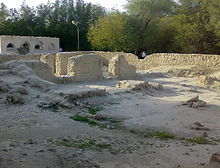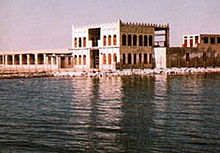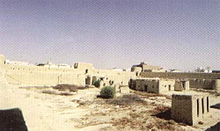- Al-Ahsa Governorate
-
- This article refers to the Saudi Arabian administrative unit sometimes called Al-Hasa. For the traditional oasis region of Al-Hasa, see: Al-Hasa. For other uses, see Al-Ahsa.
Al-Ahsa Governorate
الأحساءCoordinates: 25°23′N 49°36′E / 25.383°N 49.6°ECoordinates: 25°23′N 49°36′E / 25.383°N 49.6°E Country Saudi Arabia Government – Governor Badr Bin Muhammad Bin Abdullah Bin Jalawi Al Saud Area – City 534,000 km2 (206,178.6 sq mi) Population (2004) – City 287,841 (Al-Hofuf) (2,005 est.) – Metro 908,366 (Al-Ahsa County) Al-Ahsa (Arabic: الأحساء al-Aḥsāʾ, locally pronounced al-Ḥasāʾ) is the largest governorate in Saudi Arabia's Eastern Province, named after Al-Ahsa oasis. The name Al-Ahsa is also given to the biggest city in the region, Hofuf. In classic Arabic, Ahsa means the sound of water underground. It has one of the largest oases in the world with Date Palms of the best in the world, the oasis is located about 60 km inland from the Persian Gulf. All urban areas are located in the traditional oasis of Al-Hasa. In addition to the oasis, the county also includes the giant Empty Quarter desert, making it the largest county in Saudi Arabia in terms of area. The Empty Quarter has the world's largest oil fields and connects Saudi Arabia to Qatar, the UAE, and Oman. The Governorate's population is over 908,366 (2005 estimate[update]).[1] Though the population is mixed between Sunnis and Shi'ites, it contains one of the largest concentrations of Twelvers (اثنا عشرية) Shi'ite Muslims in the predominantly Sunni Muslim country. In the past, Al-Ahsa belonged to the historical region known as Bahrain, along with Qatif and the present-day Bahrain islands.
One campus of a major Saudi university, King Faisal University, founded in 1975, is located in Al-Ahsa with the faculties of agriculture, veterinary medicine and animal resources, with the other faculties in Dammam. The Hofuf campus also has facilities where Saudi women can study medicine, dentistry and home economics. A big branch of Arab Open University which is a private university is also located in Al-Ahsa.
Contents
History
The Al-Ahsa has been inhabited since prehistoric times, due to its abundance of water.
899: Al-Ahsa comes under control of the Qarmatian leader, Al-Jannabi, and is declared independent from the Abbasids of Baghdad. The capital is Al-Mu'miniya (near modern Hofuf).
1000: Al-Ahsa is among the 10 largest cities on earth, with 110,000 inhabitants. [2]
1077: The Qarmatian state of Al-Ahsa is overthrown by the Uyunids.
1238: Usfurid dynasty takes over the region of Al-Ahsa and Al-Qatif.
1383: Usfurids are overthrown by the Jarwanids.
1440: The Jabrids take over Al-Ahsa, Qatif, Bahrain, and Kish Island, and extend their influence to eastern Nejd.
1521: Jabrid kingdom falls to the Muntafiq tribe of southern Iraq, who rule Al-Ahsa on behalf of the Ottoman Empire. The Ottomans station their garrisons in the region.
1670: the Ottomans are expelled by the tribe of Banu Khalid, who make their capital in Al-Mubarraz.
1795: Conquered by Saudi troops during the formation of the First Saudi State.
1818: Reconquered by the Ottoman Empire by Ottoman Egyptian forces overthrowing the First Saudi State in the process and granting the local tribe of Banu Khalid self rule.
1830: Comes under the control of the Second Saudi State.
1871: The Second Saudi Dynasty loses the region to the Ottoman Empire again; however, this time it is directly ruled from Bagdad instead of by tribe of Banu Khalid under self rule has had been the case in the past during Ottoman ownerships.
1913: King Abdulaziz Al Saud conquers Al-Ahsa Oasis, annexing it into his Kingdom of Najd. (This is recognised in the Treaty of Sèvres signed in 1920 with the other official partitionings of the Ottoman Empire.)
1932: Al-Ahsa becomes part of the Kingdom of Saudi Arabia, under the King Abdulaziz.
1930s: Huge petroleum deposits are discovered near Dammam, resulting in rapid modernization for the region.
Early 1960s: The oil fields in Al-Ahsa reach the production level of 1 million barrels per day.
Population and economy
According to 2005 estimate, Al-Ahsa has over 908,000 people. All are Muslims from both Sunnah and Shi'a Islam. Over the centuries, residents of the oasis have included the Banu Abdul Qays, the Banu Uqayl, and the Bani Khalid.
Oil production and agriculture are the two main economic activities of the Al-Ahsa. Al-Ahsa is the home of some of the richest oil fields in the world.
Natural fresh-water springs have surfaced in the region for millennia, encouraging human habitation and agricultural efforts (date palm cultivation especially) since prehistoric times. The Saudi Ministry of Agriculture established a factory to process its rich date harvest at the rate of five tons daily. Other components of its agricultural output include rice, corn, citrus, and other fruits. In addition, intensive livestock raising, involving thousands of sheep, goats, cattle and camels and more than 15 major poultry farms producing more than 100 million eggs a year, make Al-Ahsa one of the major food producers for the kingdom.
Manufacturing—both the traditional small-scale cottage industry kind (e.g. the traditional mislah mantle and pottery) and large-scale industries such as cement and plastics—has also been strongly encouraged
Palm trees in Al-Ahsa
The Al-Ahsa region is boasting over 10 million palm trees.[3] The Ministry of Agriculture has set up a factory to process its rich output of dates, amounting to five tons daily.[citation needed]
Main cities
- Al-Hofuf is the capital city of the Al-Ahsa province and has many traditional markets.
- Al-Mubarraz (also spelled Al-Mobarraz), in Arabic المبرز, is one of the two main cities of the governorate.
- Al-Oyoon (also spelled Al-Uyoon or Al-Oyoun)
- Al-Omran (also spelled Al-Umran), in Arabic العمران, has an area of more than 6 km² and a population of more than 49,000 (in 1997). It consists of about 17 villages, including Al-Hutah, Al-Rumailah, North Al-Omran, South Al-Omran, Ghomsi, Al-Ulayyah, Abu Al-Hasa, Abu Thur, Al-Sayayrah, Al-Suwydrah, Al-Aramyah, Fariq Al-Raml, Wasit, Al- Shuwaikiah, Al-Sabaykh and Al-Nakheel. The Al-Sawab Club is situated in Al-Omran.[citation needed]
- Shaybah (oil town in the Empty Quarter)
Villages
Al-Ahsa is a large area where a lot of villages and small towns are located. The villages are normally grouped into two main groups according to their relative location to the oasis. Although the villages lack big markets and/or hospitals, there are few good polyclinics and small markets. You can find small bank branches and automated teller machines in many villages. Recently[when?] there have been a great improvement in road maintenance and re-construction of some main roads between villages and cities. Al-Ahsa has about 50 villages, following is a list of some according to their location:
Eastern Villages
Here is an incomplete list (population in 1997):
- Al-Taraf (+27,000) which is famous for its four hills and its small zoo. Al-Rumailah (probably +12,020) It is famous because Al-Romailah was existed when the messenger Mohamed was alive.
- Al-Holailah (+21,000)
- Al-Battaliyah (+20,000)
- Al-Shu'bah (+17,000)
- Al-Omran (+49,000) which is a well-known village and has its own municipality
- Al-Munaizlah (+17,000)
- Al-Garah (+13,000) which is well-known for its mountain Jabl Al-Garah
- Al-Jafr (+13,000) which is well known for its own police station and other government offices
- Al-Kilabiyah (+12,000)
- Al-Mansorah (+10,000)
- Al-Towaithir (+8000)
- Al-Fudhool (+8000)
- Al-Markaz (+9000) (also spelled Al-Markez), in Arabic المركز, قرية المركز. It is about 15 km from Al-Hofuf.
- Al-Hotah (Probably +7000)
- BaniMa'an
- Al-Dalwah
- Al-Shahareen
- Al-Sabat
- AbuThor
- Al-Turaibil
- Al-Tuhaimiyah
- Al-Mizawi
- Al-Jeshah(+29,000)
- Al-Jubail (+10,000).
Northern Villages
Here is an incomplete list:
- Al-Gherain
- Al-Mutairfi (+29,000) which is well-known for its natural springs
- Al-Julaijlah
- Al-Marah
- Al-Garn
- Al-Shigaig
- Al-Wazziyah.
There are also other small villages.
Climate
Al-Ahsa has a dry, tropical climate, with a five month summer and a relatively cold winter. It enjoys the benefit of copious reserves of underground water which has allowed the area to develop its agricultural potential. Nevertheless, Al-Ahsa has to deal with tons of sand which the wind carries and deposits over the land. To counter this problem, the Kingdom has planted large barriers of trees to prevent the wind-borne sand from damaging inhabited and agricultural areas.
Historical and Recreation Sites
The second oldest mosque in Islam, Jawatha Mosque, is reputed to be found here, as well, and several historic remnants of Ottoman Turkish influence can be seen in buildings such as Qasr Ibrahim and the Qasr Sahood. Many pictures of old Al-Ahsa and the Eastern Province were taken by the Danish explorer and convert to Islam Knud Holmboe (1902–1931) in his travels through the Middle East.
Here is a list of some historical and recreation sites:
- Jawatha Mosque ( Arabic = مسجد جواثا ) is considered to be the second mosque built under Islam, the first being the mosque of the Prophet Muhammad.
- Uqair (Arabic = العقير) Seaport is situated on the Persian Gulf in eastern Al-Ahsa. It has lost its focal role as a fishing and transport site, and is now an outing place for people of the region.
- Qasr Ibrahim (Arabic = قصر إبراهيم) is a castle built during Ottoman rule. It is located prominently in Al-Hofuf city.
- Natural Springs like those in Umm Sabaa provides curative mineral water at a steady rate.
- Jabl Al-Garah (Arabic = جبل القارة) is a hill (locally called a mountain) in Al-Garah a village of the same name offers visitors cool air in the summer months.
- Qasr Sahood (Arabic = قصر صاهود) is a Palace built during Ottoman rule in the city of Al-Mubarraz.
- Salwa Beach (Arabic = شاطىء سلوى) is sandy beach about 150 km from Al-Hofuf.
- Al-Shu'ba Mountain (Arabic = جبل الشعبة ) .
- Jabl Larba' (Arabic = جبل الأربع) are sandy hills about 21 km from Al-Hofuf on the way to Qatar .
- Al-Ahsa National Museum.
- Al-Ahsa National Park located at Al-Omran town.[4]
See also
Notes
- ^ Riyadh Newspaper
- ^ Recreation Utilities in Al-Ahsa by Abdullah Al-Shayeb
References
- Al-Ahsa a Geographical Study by Abdullah Al-Taher.
- Recreation Utilities in Al-Ahsa by Abdullah Al-Shayeb
External links
Categories:- Eastern Province, Saudi Arabia
- Oases of Saudi Arabia
- Governorates of Saudi Arabia
Wikimedia Foundation. 2010.



